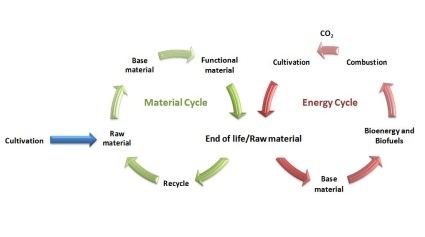Bioplastics, Bioenergy and Biofuels in Global Land Use





Competing for Land - The way we use our land is changing. As the world's population increases and greater pressure is put on global resources, we need to think carefully about how we manage the ground beneath our feet and what changes to land use will mean to businesses.
Biorenewables are renewable sources of fuel, energy and materials made from biomass. Coal and oil are just biomass that has undergone a physical and chemical change under extreme pressure and temperature, but biomass has one crucial property that makes it unique. It takes just a few years to make instead of thousands or even millions of years.
It also has a key advantage over other renewables. Biomass fixes carbon into something tangible, that can be stored and moved, and will always be available even if the sun isn't shining or the wind isn't blowing. As a source of energy we can use it to meet peak demand in national electricity grids. It is also the only low carbon liquid transport fuel. And as a source of chemicals we can use it to replace traditional plastics.
Drivers For Biomass
Consumers are increasingly familiar with words such as "green," "sustainable" and "environmentally friendly," and this is affecting buying decisions. Consequently brands are looking to demonstrate their green credentials to give them a marketplace advantage. But brands are also wary of the role non-governmental organizations have on consumer choices, as demonstrated by the Greenpeace campaign against Nestle's use of unsustainable palm oil, which resulted in changes to the company's procurement policy.
The role of the consumer in fuel and energy markets is slightly different than the plastics industry in that consumers are less willing to directly bear the higher price of renewables. Instead, more environmentally friendly fuel and energy alternatives are mandated through government targets, and strict sustainability criteria ensure biomass is responsibly sourced.
Growing Biomass
Conventional sources of biomass require land, and the amount we are predicted to need for bioplastics, biofuels and bioenergy could be huge. On paper we have plenty of room to grow enough crops to meet all our short-term needs. According to the Food and Agriculture Organization (FAO) and the Organization for Economic Co-operation and Development (OECD), we could more than double the amount of land in crop production around the globe, from 1,400 million to more than 3,300 million hectares.
However, using this land may not be sustainable. Population growth, protection of food security and changing diets will increase the competition for land. We also need to protect our forests, areas of high biodiversity and ecosystem services, which leaves between 250 and 800 million hectares of land available for bioplastic, bioenergy and biofuel crops.
But precisely how much biomass do we need, and what could this mean for land use? Much depends on how markets and technologies develop. In addition, just how quickly can we continue toward an economy based on integrated biorefineries, where food, feed and fuel are co-produced efficiently?
These are questions that cannot wait. The decisions we make today could determine the success of the industry. Evidence suggests we have already reached "peak oil," so we need to act now. The world simply cannot afford to wait. Businesses need to be aware of what the future holds and how they can be proactive rather than reactive to the changing marketplace.
Land Availability Up to 2030
If the bioplastics industry continues to grow at its current rate, bioplastics could replace up to 10 % of all plastics by 2030. This could require around 17 million hectares of land.
But demands on land caused by the expansion of the global bioplastic market will be dwarfed by the use of biomass for energy and fuels. Although bioenergy and biofuels will increasingly utilize non-food feedstocks to meet sustainability demands, crops grown for energy and fuel production could use between 50 and 300 million hectares by 2030.
Ample Room?
Given this level of market growth it is likely we would require 60-317 million hectares by 2030, which falls within the range of land potentially available for bioenergy, biofuels and bioplastics crops.
But even converting this "available" land remains a challenge, as much of it is on continents such as Africa and South America, often far from agricultural infrastructure; significant investment would be needed to make this land available for cultivating crops.
In addition, when we look further into the future, land is likely to become further constrained, as the finite amount of land we have available is put under increased pressure from the growing global economy. By 2050, bioplastics could account for up to 20 % of all plastics or around 142 million tons per year. This would require 30-38 million hectares of land.
The use of biomass for energy and fuels will also continue to increase. Should bioenergy and biofuels represent 20 % of the total global energy market by 2050, the land needed for crops could rise to 700 million hectares.
This means that altogether we may need more than 730 million hectares to meet our 2050 requirements for bioplastics, biofuels and bioenergy, which could seriously test the limits of the amount of land sustainably available for crops. As competition for resources increases this could drive up feedstock costs and put greater pressure on sustainability, directly or indirectly affecting biodiversity, water and fertilizer use across the globe. For example, some parts of America, Western Europe and Southern Asia may become almost entirely dependent on imports of nutrients.
What Is the Solution?
Competition for land is here to stay and we must:
- Use our resources better by driving innovation
- Use more lignocellulosic crops, algae, residues and wastes
- Push policies toward sectors with limited alternatives
By building refineries that produce food, feed, fuel, chemicals and nutrients efficiently, we can minimize waste and ensure a wide range of biochemicals and biofuels are produced and tailored for specific purposes. We must also strive to develop bioplastics that minimize land requirements.
Technological advances in fermentation, gasification and pyrolysis have also made it possible to convert household rubbish, waste wood and agricultural residues into fuels and energy. In particular there is growing interest in the fermentation of syngas, a promising combination of biological and chemical treatments.
Innovations in the production of chemicals and materials from agricultural residues are also expanding. There is significant potential to reduce demands on land by using agricultural residues. High volumes of agricultural residues are generated in South America and Asia, and they are expected to increase further in the medium term as food production rises.
Improved breeding will increase the productivity of crops, particularly lignocellulosic crops, like willow and Miscanthus, which have been largely uncultivated. An annual yield increase of 2 % would double production volumes without land expansion.
In many cases there are also alternative sources of renewable energy and fuels that can replace petrochemicals, but biomass is our only low-carbon alternative to aviation and marine fuels and in the manufacturing of plastics. In the short-term these markets will benefit from the growth of biofuel and bioenergy, including logistical and technology developments such as the ability to process lignocellulosic feedstocks like wood. But we urgently need to develop clear strategies and policies to support the development of sectors with limited renewable options.
Conclusion
Businesses will increasingly be judged on their ability to manage supply chains sustainably. This will rely on the development and implementation of suitable assessment tools and procedures.
We must learn how to use the resources we have now to create a more sustainable future. Understanding the future will allow businesses to develop the infrastructure, market and knowledge that will give them the edge over their competitors.





